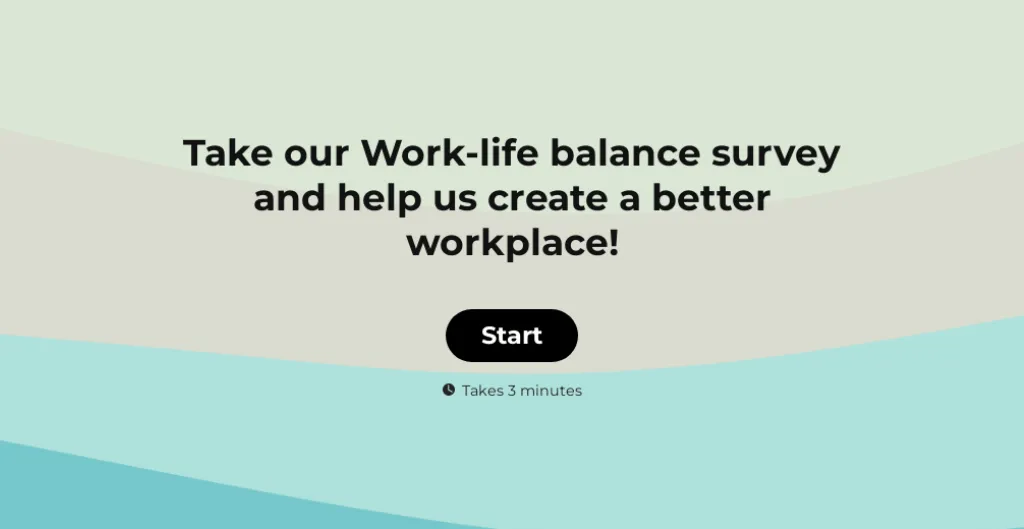7 min read
Empower employees while caring for employee well-being. Prevent employee burnout and depression.
ex Platform
In today’s fast-paced and competitive work environment, achieving a healthy balance between professional responsibilities and personal well-being has become increasingly important. Employee work-life balance is more than just a buzzword; it’s fundamental to a successful and sustainable workplace and employee experience. Let’s investigate what work-life balance entails and explore the significant benefits employers should consider offering their workforce.
What is a good work-life balance?
A good work-life balance is an important aspect of maintaining a healthy lifestyle. Achieving this balance requires consciously managing one’s professional responsibilities and personal commitments while caring for physical, mental, and emotional well-being. This can involve setting clear boundaries between work and personal life, prioritizing self-care activities such as exercise and mindfulness, and developing strong relationships with family and friends. It’s also important to recognize that work-life balance is not a one-size-fits-all approach and may vary depending on individual circumstances, such as career goals and family responsibilities. Ultimately, finding the right balance involves continuous reflection and adjustment to ensure that all life areas are properly addressed and fulfilled.
Employers have a significant role in promoting work-life balance among their employees. By offering flexible work arrangements, such as telecommuting and flexible hours, employers can help their employees better manage their work and personal lives. Encouraging employees to take regular breaks and providing resources for mental health support can also help improve work-life balance. In addition to improving employee well-being, promoting work-life balance can lead to increased productivity and employee retention.
Equally important is the provision of robust well-being and mental health support for your workforce. This is imperative because neglecting employee well-being puts them at risk of encountering multiple adverse outcomes. Without adequate investment in well-being, employees may experience burnout, leading to reduced productivity and heightened safety hazards. Among these potential risks are workplace accidents, which carry significant emotional, physical, and financial repercussions.
8 ways to help your employees balance work and life
Balancing work and life is essential for employee well-being and overall satisfaction. Employers can play a crucial role in facilitating this balance. Here are five effective ways to help your employees achieve a healthier equilibrium between their professional and personal lives:
Flexible Work Arrangements: Offer flexible work options such as remote work, flexible hours, or compressed workweeks. Allowing employees to adjust their schedules to accommodate personal needs can significantly improve their work-life balance.
Clear Communication of Expectations: Set work hours, response times, and availability expectations. This clarity helps employees manage their time effectively and reduces the pressure to constantly connect. Encouraging managers to be approachable and accessible is another important aspect of creating an open communication culture.
Promote Self-Care and Wellness: Encourage and provide resources for employee well-being initiatives, such as wellness programs, mental health resources, and access to fitness facilities. Prioritizing physical and mental health contributes to a balanced lifestyle.
Unlimited Paid Time Off (PTO): Consider implementing unlimited PTO policies where employees can take time off when needed, without rigid limits. This empowers employees to manage their own time and take breaks when required.
Regular Check-ins and Feedback: Schedule regular one-on-one meetings with employees to discuss workloads, challenges, and opportunities for support. Providing a platform for open communication helps address potential issues and ensures employees feel valued.
Encourage Boundaries: Advocate for setting clear boundaries between work and personal time. Encourage employees to disconnect from work-related tasks outside of designated hours and discourage after-hours emails or messages. Respect these boundaries to prevent burnout and allow employees to recharge.
Offer Remote Work Options: Provide the opportunity for employees to work remotely, at least part of the time. Remote work can eliminate long commutes and offer a more flexible environment, enabling employees to manage their time and commitments better.
Provide Family-Friendly Policies: Implement family-friendly policies such as parental leave, flexible parental work arrangements, and childcare support. These policies acknowledge employees’ challenges in juggling work and family responsibilities, contributing to a more inclusive and supportive workplace.
By implementing these strategies, you demonstrate a genuine commitment to your employee’s work-life balance, fostering a positive work environment and contributing to their overall well-being.
The business benefits of employee work-life balance
Employee work-life balance doesn’t just benefit individual employees; it also substantially positively affects a business’s overall health and success.
Enhanced Employee Productivity: When employees have a healthy work-life balance, they are more likely to be focused, motivated, and energized during work hours. This heightened focus translates into increased productivity and the ability to accomplish tasks more efficiently.
Reduced Burnout and Turnover: A workplace that prioritizes work-life balance helps prevent employee burnout. Burnout can lead to decreased job satisfaction and higher turnover rates. By valuing employees’ personal time and well-being, you can retain valuable talent and reduce the costs associated with turnover.
Higher Job Satisfaction and Employee Engagement: Employees who feel their employer cares about their work-life balance are more likely to be satisfied with their job and engaged in their roles. Engaged employees are more committed, innovative, and contribute positively to the work environment.
Attracting Top Talent: In a competitive job market, organizations prioritizing work-life balance have an advantage in attracting skilled and motivated job seekers. Prospective employees are more likely to be drawn to companies committed to employee well-being.
Positive Company Culture: A work culture that respects and supports work-life balance fosters a positive and inclusive environment. This culture promotes teamwork, collaboration, and better employee relationships, which can enhance overall organizational performance.
How Employers Can Navigate Remote Work Successfully
When opting to provide your employees with flexible hours and the option to work remotely, it’s important to establish a foundation of trust while maintaining effective communication. Transitioning to this new work model requires a balanced approach to ensure both productivity and well-being. Here’s a set of recommended practices and potential pitfalls to consider during this shift:
DOs:Foster Personal Connections: Emphasize the importance of maintaining personal connections with remote employees. Opt for video conferencing tools over emails to facilitate face-to-face interactions, creating a stronger sense of engagement and collaboration.
Encourage Communication: Establish open lines of communication and encourage remote employees to reach out with any concerns, questions, or updates. Regular check-ins and team meetings can help maintain a sense of unity and shared purpose.
Acknowledge Achievements: Recognize and celebrate accomplishments and milestones, whether they occur in the office or remotely. Acknowledging remote employees’ contributions reinforces their value within the team.
Promote Flexibility: Advocate for a healthy work-life balance by allowing flexible work hours and acknowledging that remote employees may have varying schedules due to personal commitments.
Micro-Manage Time: Resist the urge to monitor remote employees’ work hours excessively. Micromanagement can lead to decreased morale and hinder the autonomy that often drives remote workers’ productivity.
Jump to Conclusions: Avoid immediately investigating time or performance changes. Instead, engage in open conversations to understand potential challenges or adjustments.
Isolate Remote Workers: Strive to include remote employees in company-wide activities and initiatives. This helps maintain a sense of belonging and ensures they benefit from the organization’s resources and opportunities.
Exclude from Programs: Refrain from excluding remote employees from well-being programs. Extend these initiatives to remote staff to demonstrate their value and prioritize their overall health and happiness.
How can online surveys help to maintain a work-life balance?
Online surveys play a pivotal role in maintaining work-life balance by providing a direct channel for employees to voice their concerns and preferences. Work-life balance survey gather real-time insights into employees’ challenges, helping organizations tailor strategies to enhance balance. Through anonymous participation, employees feel safe sharing their experiences, enabling employers to identify and address specific pain points effectively.

The data collected serves as a compass for designing flexible work arrangements, wellness programs, and support mechanisms that resonate with employees’ needs. Regular surveys ensure ongoing monitoring, enabling prompt adjustments and demonstrating an organizational commitment to employee well-being. In cultivating an open dialogue and involving employees in shaping solutions, online surveys foster engagement and ownership, fostering a culture of mutual understanding. As survey results inform tangible changes, organizations can tangibly measure progress, ensuring sustained efforts toward a harmonious work-life balance for a more fulfilled and productive workforce.






